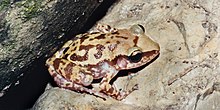Eleutherodactylus longipes
Eleutherodactylus longipes is a species of frog in the family Eleutherodactylidae. It is endemic to Mexico and occurs on the Sierra Madre Oriental between central Nuevo León and adjacent Coahuila in the north and northern Hidalgo in the south. It is also known as the long-footed chirping frog and longfoot robber frog, among other names.[1][2]
| Eleutherodactylus longipes | |
|---|---|
 | |
| Long-footed Chirping Frog, Victoria, Tamaulipas, Mexico (12 July 2004) | |
| Scientific classification | |
| Kingdom: | Animalia |
| Phylum: | Chordata |
| Class: | Amphibia |
| Order: | Anura |
| Family: | Eleutherodactylidae |
| Genus: | Eleutherodactylus |
| Subgenus: | Syrrhophus |
| Species: | E. longipes |
| Binomial name | |
| Eleutherodactylus longipes (Baird, 1859) | |
| Synonyms[2] | |
| |
Eleutherodactylus longipes occurs in pine-oak forests at elevations of 650–2,000 m (2,130–6,560 ft) above sea level. Several records are from caves. It is threatened by habitat loss caused by logging. Chytridiomycosis remains a potential threat. It might be present in the Cumbres de Monterrey National Park.[1]
References
- IUCN SSC Amphibian Specialist Group. (2020). "Eleutherodactylus longipes". IUCN Red List of Threatened Species. 2020: e.T56727A53965237. Retrieved 17 July 2020.
- Frost, Darrel R. (2018). "Eleutherodactylus longipes (Baird, 1859)". Amphibian Species of the World: an Online Reference. Version 6.0. American Museum of Natural History. Retrieved 22 October 2018.
This article is issued from Wikipedia. The text is licensed under Creative Commons - Attribution - Sharealike. Additional terms may apply for the media files.
